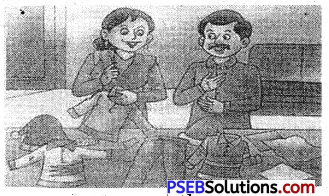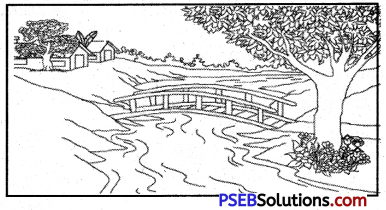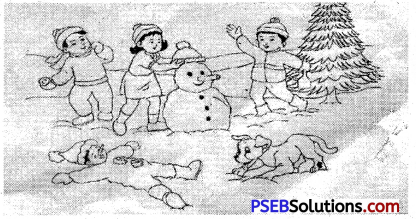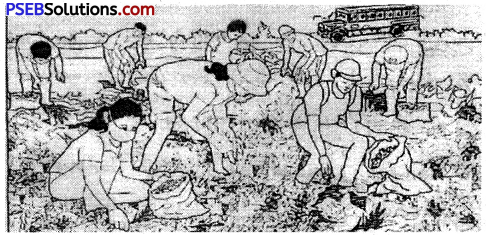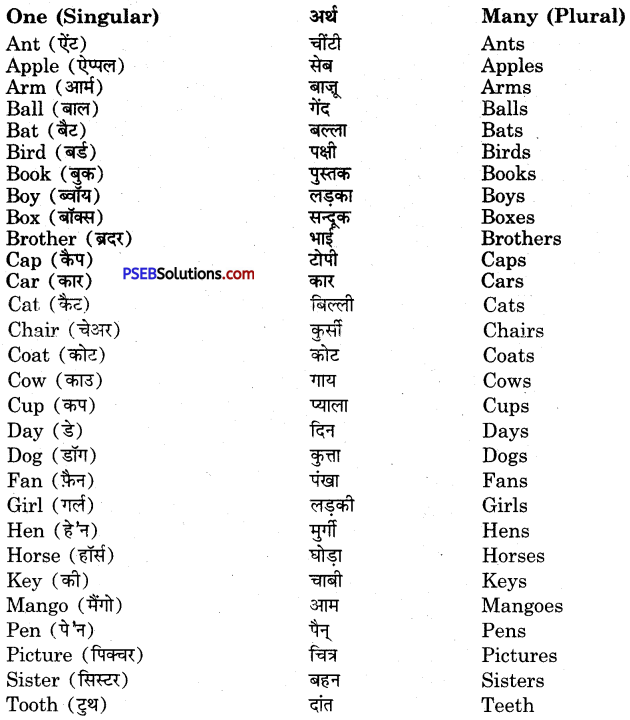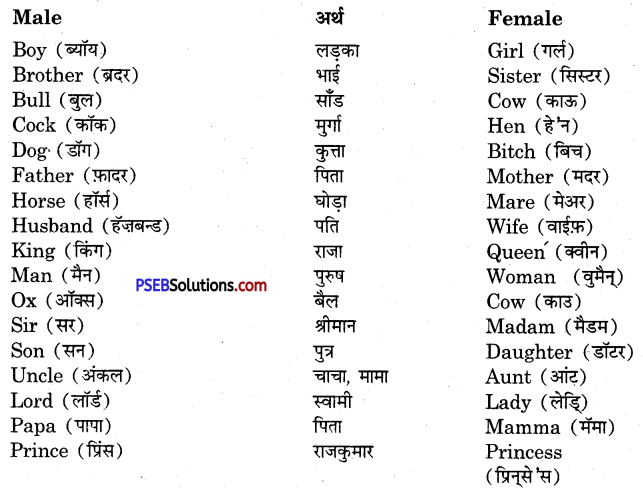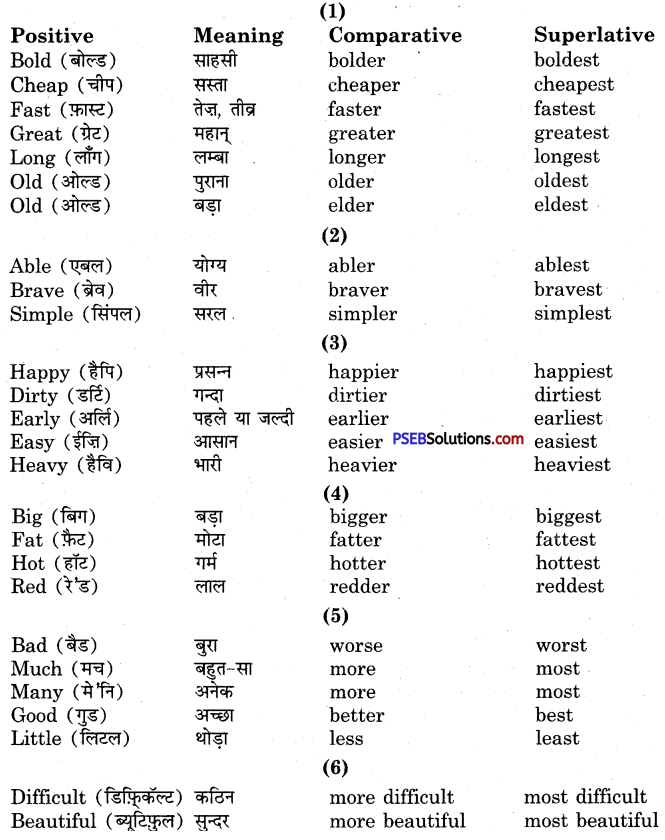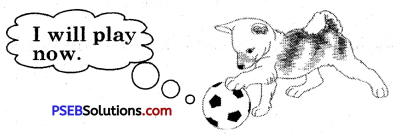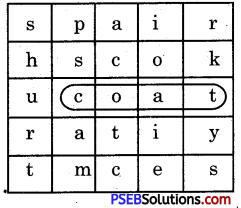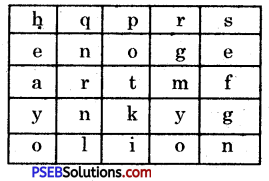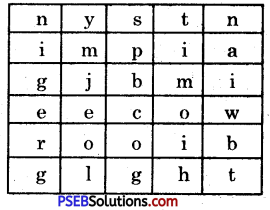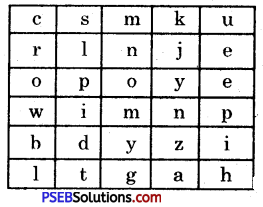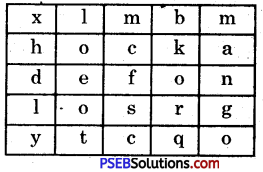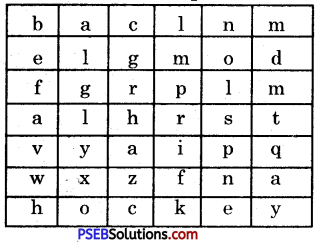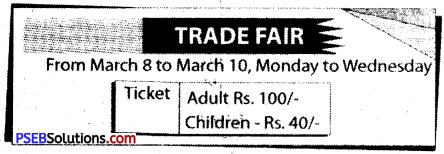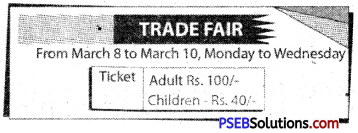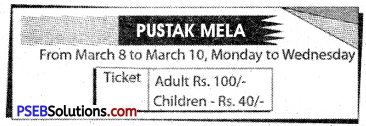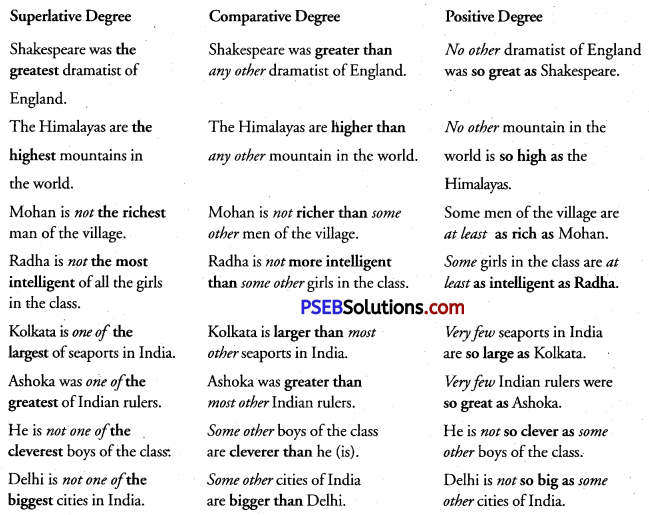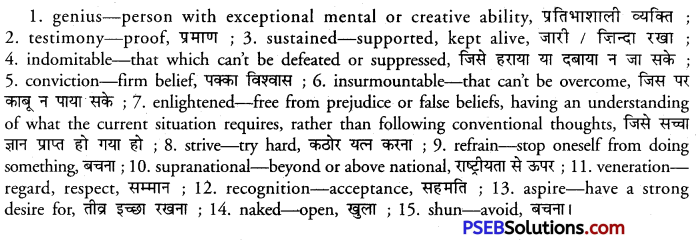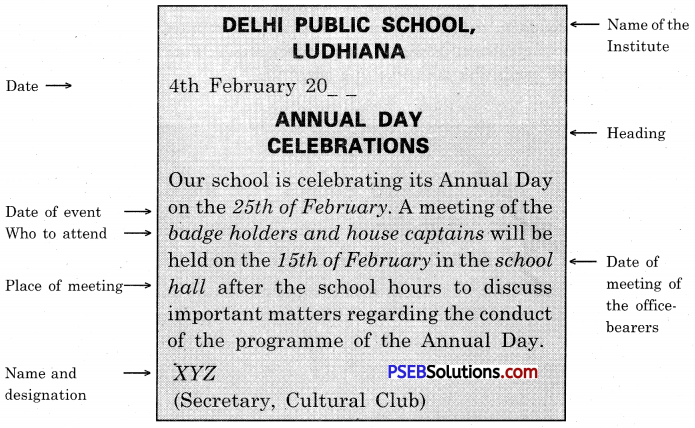Punjab State Board PSEB 5th Class English Book Solutions English Reading Comprehension Passages Exercise Questions and Answers, Notes.
PSEB 5th Class English Reading Comprehension Passages
Read the following passages/stanzas and answer the questions given below each:
(1) Once there was a shoemaker. He became so poor that he had nothing left to run his family but only enough leather for just one pair of shoes. So, in the evening, he cut out the leather with great care to make the shoes. But he was so disappointed that he left his work on the table to finish in the morning. He was almost in tears. Before he fell asleep, he prayed to God and asked to help him.
(A) Question 1.
What was the shoemaker’s problem?
(ਜੁੱਤੀਆਂ ਬਣਾਉਣ ਵਾਲੇ ਦੀ ਕੀ ਸਮੱਸਿਆ ਸੀ ?)
जूते बनाने वाले की क्या समस्या थी ?
Answer:
The shoemaker had become very poor. He had nothing left to run his family.
(ਜੁੱਤੀਆਂ ਬਣਾਉਣ ਵਾਲਾ ਬਹੁਤ ਹੀ ਗਰੀਬ ਹੋ ਗਿਆ ਸੀ । ਆਪਣਾ ਪਰਿਵਾਰ ਚਲਾਉਣ ਦੇ ਲਈ ਉਸ ਦੇ ਕੋਲ ਕੁਝ ਨਹੀਂ ਬਚਿਆ ਸੀ )
जूते बनाने वाला बहुत ही ग़रीब हो गया था। अपना परिवार चलाने के लिए उसके पास कुछ बाच था।
![]()
Question 2.
How much leather did he have ?
(ਉਸ ਕੋਲ ਕਿੰਨਾ ਚਮੜਾ ਸੀ?)
उसके पास कितना चमड़ा था ?
Answer:
He had leather only for one pair of shoes.
((ਉਸ ਦੇ ਕੋਲ ਸਿਰਫ਼ ਇਕ ਜੋੜੀ ਜੁੱਤੀਆਂ ਦਾ ਜੋੜਾ ਬਣਾਉਣ ਲਈ ਚਮੜਾ ਸੀ ।)
उसके पास केवल एक जोड़ी जूते बनाने का चमड़ा था।
Question 3.
What for did he pray to God ?
(ਉਸਨੇ ਪ੍ਰਮਾਤਮਾ ਅੱਗੇ ਕਿਸੇ ਵਾਸਤੇ ਅਰਦਾਸ ਕੀਤੀ ?)
उसने परमात्मा से किस बात की प्रार्थना की ?
Answer:
He prayed to God for help.
((ਉਸਨੇ ਪਰਮਾਤਮਾ ਅੱਗੇ ਸਹਾਇਤਾ ਲਈ ਅਰਦਾਸ ਕੀਤੀ ।)
(B) Write True / False for the following sentences:
(a) The shoemaker became a very rich.
(b) He asked God to help him.
(c) He cut out the leather carelessly.
(d) He was almost in tears.
Or
Give the opposite of the following words:
(a) poor ………….
(b) morning ………..
(c) nothing ……….
Or
Complete the following sentences:
(a) He left his work on the ………. to finish in the ……….
(b) He was almost in …………… .
Answer:
(a) False
(b) True
(c) False
(d) True
Or
(a) rich
(b) evening
(c) everything
Or
(a) He left his work on the table to finish it in the morning.
(b) He was almost in tears.
(2) In the morning, he found a wonderful pair of shoes on his table. He was surprised. He took the shoes in his hands and looked at them closely. They were so neatly made that there was not even one bad stitch on them. The pair of shoes was, indeed, a masterpiece.
Soon after, a customer came into the shop. He liked the shoes and paid more than the usual price. Now, the shoemaker was very happy as he had enough money to buy leather for two pairs of shoes.
(A) Question 1.
What did the shoemaker find in the morning ?
(ਜੁੱਤੀਆਂ ਬਣਾਉਣ ਵਾਲੇ ਨੂੰ ਸਵੇਰੇ ਕੀ ਲੱਭਿਆ ?)
जूते बनाने वाले ने सुबह क्या देखा ?
Answer:
The shoemaker found a wonderful pair of shoes in the morning.
(ਜੁੱਤੀਆਂ ਨਿਰਮਾਤਾ ਨੂੰ ਜੁੱਤੀਆਂ ਦਾ ਇਕ ਅਦਭੁੱਤ ਜੋੜਾ ਲੱਭਿਆ ॥
जूता निर्माता ने सुबह जूतों का एक अद्भुत जोड़ा देखा।
Question 2.
What made the pair of shoes a masterpiece ?
(ਜੁੱਤੀਆਂ ਦੀ ਜੋੜੀ ਨੂੰ ਇੱਕ ਮਾਸਟਰਪੀਸ ਕਿਸ ਚੀਜ਼ ਨੇ ਬਣਾਇਆ?)
कौन सी बात जूतों के जोड़े को शानदार कृति बनाती थी ?
Answer:
Fine stiching of the shoes made them a masterpiece.
((ਜੁੱਤੀਆਂ ਦੀ ਵਧਿਆ ਸਿਲਾਈ ਉਨ੍ਹਾਂ ਨੂੰ ਸ਼ਾਨਦਾਰ ਕ੍ਰਿਤੀ ਬਣਾਉਂਦੀ ਸੀ ।
जूतों की बढ़िया सिलाई उन्हें शानदार कृति बनाती थी।
Question 3.
What price did the shoemaker get for the shoes ?
(ਜੁੱਤੀ ਬਣਾਉਣ ਵਾਲੇ ਨੂੰ ਜੁੱਤੀ ਦੀ ਕੀ ਕੀਮਤ ਮਿਲੀ?)
जूता निर्माता को जूतों की कितनी कीमत मिली ?
Answer:
He got more than usual price for the shoes.
(ਉਸਨੂੰ ਜੁੱਤੀਆਂ ਦੀ ਸਾਧਾਰਨ ਤੋਂ ਵੀ ਜ਼ਿਆਦਾ ਕੀਮਤ ਮਿਲੀ । )
उसे जूतों की सामान्य से भी अधिक कीमत मिली।
(B) Write True / False for the following sentences:
(a) He found a wonderful pair of shoes.
(b) He was sad.
(c) The customer liked the shoes.
(d) He threw the shoes away.
Or
Give the opposite of the following words:
(a) bad …………
(b) found …………..
(c) after ………………
Or
Complete the following sentences:
(a) He took the shoes in his ………… and ……… at them.
(b) He had enough money to buy leather for ………..
Answer:
(a) True
(b) False
(c) True
(d) False.
Or
(a) He took the shoes in his hands and looked at them.
(b) He had enough money to buy leather for two pairs of shoes.
Or.
(a) good
(b) lost
(c) before.
(3) The woman said, “Those little men have made us rich. We should show our gratitude to them for their selfless service. I will make little shirts, coats, vests, trousers and a pair of socks for them.” “Ok, then I will make two little pairs of shoes for them,” said the shoemaker.
When everything was ready, they laid their presents on the table and hid themselves. At midnight, the elves came in. They were delighted to find the gifts. Both the elves dressed themselves in the new clothes. Then, they danced and sang happily.
(A) Question 1.
Why did the woman want to show gratitude to the little men ?
(ਔਰਤ ਬੌਨਿਆਂ ਦਾ ਅਹਿਸਾਨ ਕਿਉਂ ਜਤਾਉਣਾ ਚਾਹੁੰਦੀ ਸੀ ?)
औरत बौनों का आभार क्यों जताना चाहती थी ?
Answer:
The woman wanted to show gratitude to them for their selfless service.
((ਔਰਤ ਬੌਨਿਆਂ ਦੀ ਨਿਰਸਵਾਰਥ ਸੇਵਾ ਦੇ ਲਈ ਉਨ੍ਹਾਂ ਦਾ ਅਹਿਸਾਨ ਜਤਾਉਣਾ ਚਾਹੁੰਦੀ ਸੀ ॥)
औरत बौनों की नि:स्वार्थ सेवा के लिए उनका आभार जताना चाहती थी।
Question 2.
What did the shoemaker want to do for them ?
(ਜੁੱਤੀਆਂ ਦਾ ਨਿਰਮਾਤਾ ਉਨ੍ਹਾਂ ਦੇ ਲਈ ਕੀ ਕਰਨਾ ਚਾਹੁੰਦਾ ਸੀ ?)
जूता निर्माता उनके लिए क्या करना चाहता था ?
Answer:
The shoemaker wanted to make two little pairs of shoes for them.
(ਜੁੱਤੀਆਂ ਦਾ ਨਿਰਮਾਤਾ ਉਨ੍ਹਾਂ ਦੇ ਲਈ ਦੋ ਜੋੜੀਆਂ ਛੋਟੀਆਂ ਜੁੱਤੀਆਂ ਬਣਾਉਣਾ ਚਾਹੁੰਦਾ ਸੀ )
जूता निर्माता उनके लिए दो जोड़ी छोटे जूते बनाना चाहता था।
Question 3.
What made the little men feel happy ?
((ਬੌਨਿਆਂ ਨੂੰ ਕਿਸ ਗੱਲ ਦੇ ਕਾਰਨ ਖੁਸ਼ੀ ਹੋਈ ?))
बौनों को किस बात के कारण खुशी हुई ?
Answer:
The gifts for them on the table made the little men feel happy.
(ਬੌਨਿਆਂ ਨੂੰ ਆਪਣੇ ਲਈ ਤੋਹਫੇ ਦੇਖ ਕੇ ਖੁਸ਼ੀ ਹੋਈ ॥)
बौनों को मेज़ पर उनके लिए पड़े तोहफों को देख कर खुशी हुई।
(B) Write True / False for the following sentences:
(a) The little men had made them rich.
(b) They laid their presents on the chairs.
(c) The elves were happy to find the gifts.
(d) The elves came early in the morning.
Or
Give the opposites of the following words:
(a) selfless ………….
(b) little ………. .
(c) new …………
Or
Complete the following sentences:
(a) Both the elves dressed themselves in ………… .
(b) They laid their presents on the …….. and hid ………..
Answer:
(a) True
(b) False
(c) True
(d) False.
Or
(a) selfish
(b) big
(c) old.
Or
(a) Both the elves dressed themselves in the new clothes.
(b) They laid their presents on the table and hid themselves.
![]()
(4) Pala said, “Dear, look at the buildings. How tall they are ! Our village is now on the way to advancement”. Beero grumbled, “Advancement ! Don’t you realize that our health is at stake ?” “What are you saying ?” asked Pala. “You need to look around you,” said Beero. “People have beautiful homes with all kinds of facilities but they are not using them properly.”
(A) Question 1.
How does Pala feel about their village ?
(ਪਾਲਾ ਆਪਣੇ ਪਿੰਡ ਦੇ ਬਾਰੇ ਵਿਚ ਕਿਸ ਤਰ੍ਹਾਂ ਮਹਿਸੂਸ ਕਰਦਾ ਹੈ ?)
पाला अपने गांव के बारे में कैसा महसूस करता है ?
Answer:
Pala feels that their village is on the way to advancement.
(ਪਾਲਾ ਮਹਿਸੂਸ ਕਰਦਾ ਹੈ ਕਿ ਉਨ੍ਹਾਂ ਦਾ ਪਿੰਡ ਤਰੱਕੀ ਕਰ ਰਿਹਾ ਹੈ ॥)
पाला महसूस करता है कि उनका गांव तरक्की कर रहा है।
Question 2.
Does Beero agree with him ? How does she feel ?
(ਕੀ ਬੀਰੋ ਉਸ ਨਾਲ ਸਹਿਮਤ ਹੈ ? ਉਹ ਕਿਸ ਤਰ੍ਹਾਂ ਮਹਿਸੂਸ ਕਰਦੀ ਹੈ ?)
क्या बीरो उससे सहमत है ? वह कैसा महसूस करती है ?
Answer:
No, Beero does not agree with him. She feels that their health is at stake.
( ਨਹੀਂ ਬੀਰੋ ਉਸਦੇ ਨਾਲ ਸਹਿਮਤ ਨਹੀਂ ਹੈ । ਉਹ ਮਹਿਸੂਸ ਕਰਦੀ ਹੈ ਕਿ ਉਨ੍ਹਾਂ ਦੀ ਸਿਹਤ ਖ਼ਤਰੇ ਵਿਚ ਹੈ ॥)
नहीं, बीरो उससे सहमत नहीं है। वह महसूस करती है कि उनका स्वास्थ्य खतरे में है।
Question 3.
What kind of homes do the people have in the village ?
(ਪਿੰਡ ਵਿਚ ਲੋਕਾਂ ਦੇ ਕੋਲ ਕਿਸ ਤਰ੍ਹਾਂ ਦੇ ਘਰ ਹਨ ?)
गांव में लोगों के पास कैसे घर हैं ?
Answer:
They have beautiful homes with all kinds of facilities.
(ਉਨ੍ਹਾਂ ਦੇ ਕੋਲ ਸੁੰਦਰ ਘਰ ਹਨ, ਜਿਨ੍ਹਾਂ ਵਿਚ ਹਰ ਤਰ੍ਹਾਂ ਦੀਆਂ ਸੁਵਿਧਾਵਾਂ ਹਨ )
उनके पास सुंदर घर हैं जिनमें सभी प्रकार की सुविधाएं हैं।
(B) Write True / False for the following sentences:
(a) The buildings were tall.
(b) People had beautiful homes.
(c) Their health was not/at stake.
(d) Beero grumbled at the word advancement used for the village.
Or
Give the opposites of the following words:
(a) tall …………. .
(b) beautiful ……… .
(c) now ………. .
Or
Complete the following sentences:
(a) People are not using their homes ………………
(b) The buildings in the village are ………..
Answer:
(a) True
(b) True
(c) False
(d) True
Or
(a) tiny / small
(b) ugly
(c) there.
Or
(a) People are not using their homes properly.
(b) The buildings in the village are very tall.
(5) “What do you want to say?” asked Pala. Beero responded, “They are not using their toilets.” “What !” exclaimed Pala. Beero continued, “They defecate in the open, near my home. This place stinks ! I am fed up of this unpleasant odour. They are not even afraid of the danger they are going to face.”
(A) Question 1.
What wrong thing are the people doing ?
(ਲੋਕ ਕੀ ਗ਼ਲਤ ਕੈਮ ਕਰ ਰਹੇ ਹਨ ?)
लोग क्या ग़लत काम कर रहे हैं ?
Answer:
They are not using their toilets and defecate in the open.
(ਉਹ ਆਪਣੇ ਟਾਇਲੈਟ ਦਾ ਪ੍ਰਯੋਗ ਨਾ ਕਰਕੇ ਖੁੱਲ੍ਹੇ ਸ਼ੌਚ ਕਰਦੇ ਹਨ ॥)
वे अपने टॉयलट्स का प्रयोग न करके खुले में शौच करते हैं।
Question 2.
Why does the place stink ?
(ਉਸ ਜਗ੍ਹਾ ਤੇ ਬਦਬੂ ਕਿਉਂ ਆਉਂਦੀ ਹੈ ?)
उस स्थान से दुर्गंध क्यों आती है ?
Answer:
The place stinks because the people defecate near it.
(ਉਸ ਸਥਾਨ ਤੋਂ ਬਦਬੂ ਇਸ ਲਈ ਆਉਂਦੀ ਹੈ, ਕਿਉਂਕਿ ਲੋਕ ਉਸਦੇ ਨੇੜੇ ਸ਼ੌਚ ਕਰਦੇ ਹਨ ॥)
उस स्थान से दुर्गंध इसलिए आती है क्योंकि लोग उसके निकट शौच करते हैं।
Question 3.
What is Beero fed up of ?
(ਬੀਰੋ ਕਿਸ ਗੱਲ ਤੋਂ ਦੁਖੀ ਹੈ ?)
बीरो किस बात से दुःखी है ?
Answer:
Beero is fed up of unpleasant odour.
(ਬੀਰੋ ਬਦਬੂ ਤੋਂ ਦੁਖੀ ਹੈ ॥)
बीरो दुर्गंध से दुःखी है।
(B) Write True / False for the following sentences:
(a) Beero did not respond to Pala’s question
(b) People were using their toilets.
(c) They defecated in the open.
(d) People were afraid of the danger.
Or
Give the opposite of the following words:
(a) near …………. .
(b) unpleasant ………. .
(c) open ………. .
Or
Complete the following sentences:
(a) They are not afraid of the ……… they are going to …………
(b) People defecate in the ………….. near ………….. home.
Answer:
(a) False
(b) False
(c) True
(d) False.
Or
(a) far
(b) pleasant
(c) covered / hidden.
Or
(a) They are not afraid of the danger they are going to face.
(b) People defecate in the open near Beero’s home.
(6) Grandmother and I.
We often sigh,
At the big adult world.
An alien world.
(A) Question 1.
Name the poem.
(ਕਵਿਤਾ ਦਾ ਨਾਂ ਦੱਸੋ )
कविता का नाम बताओ?
Answer:
The name of the poem is ‘Child and Grandma’.
(ਕਵਿਤਾ ਦਾ ਨਾਂ ‘Child and Grandma’ ਹੈ)
कविता का नाम ‘Child and Grandma’ हैं।
Question 2.
What do Grandmother and the child sigh at ?
(ਦਾਦੀ ਮਾਂ ਅਤੇ ਬੱਚਾ ਆਹ ਕਿਉਂ ਭਰਦੇ ਹਨ ?)
दादी माँ और बच्चा आह क्यों भरते हैं ?
Answer:
They sigh at the big adult world.
(ਉਹ ਬਾਲਗਾਂ ਦੇ ਵੱਡੇ ਸੰਸਾਰ ’ਤੇ ਆਹ ਭਰਦੇ ਹਨ । )
वे वयस्कों के बड़े संसार पार आह भरते हैं।
Question 3.
What do they call the big adult world ?
(ਉਹ ਬਾਲਗਾਂ ਦੇ ਵੱਡੇ ਸੰਸਾਰ ਨੂੰ ਕੀ ਕਹਿ ਕੇ ਬੁਲਾਉਂਦੇ ਹਨ ?)
वे वयस्कों के बड़े संसार को क्या कह कर पुकारते हैं ?
Answer:
They call it an alien world.
(ਉਹ ਇਸਨੂੰ alien world ਕਹਿ ਕੇ ਬੁਲਾਉਂਦੇ ਹਨ ॥)
वे इसे alien world कह कर पुकारते हैं।
(B) Complete the following lines:
(a) We often ………….
(b) The child is with its ………
Answer:
(a) We often sigh.
(b) The child is with its grandmother.
(7) I caress her wrinkled skin.
In her I find my kin.
We are so much alike.
We think so alike.
(A) Question 1.
Whose skin is wrinkled ?
(ਝੁਰੜੀਆਂ ਵਾਲੀ ਚਮੜੀ ਕਿਸ ਦੀ ਹੈ ?))
झुरियों वाली त्वचा किसकी है?
Answer:
Grandma’s skin is wrinkled.
(ਦਾਦੀ ਮਾਂ ਦੀ ਚਮੜੀ ਝੁਰੜੀਆਂ ਵਾਲੀ ਹੈ ।)
Question 2.
How are the child and its grandmother alike ?
(ਬੱਚਾ ਅਤੇ ਦਾਦੀ ਮਾਂ ਕਿਸ ਤਰ੍ਹਾਂ ਇਕੋ ਜਿਹੇ ਹਨ ?)
बच्चा और दादी माँ किस तरह एक जैसे हैं ?
Answer:
Both feel oneness with each other. They think alike.
(ਦੋਵੇਂ ਇਕ-ਦੂਸਰੇ ਦੇ ਨਾਲ ਜੁੜਿਆ ਹੋਇਆ ਅਨੁਭਵ ਕਰਦੇ ਹਨ । ਉਹ ਇਕੋ ਜਿਹਾ ਸੋਚਦੇ ਹਨ ॥)
दोनों एक-दूसरे से जुड़ा हुआ अनुभव करते हैं। वे एक जैसा सोचते हैं।
Question 3.
Name the poem.
(ਕਵਿਤਾ ਦਾ ਨਾਂ ਲਿਖੋ !)
कविता का नाम बताओ?
Answer:
The name of the poem is ‘Child and Grandma’.
(ਕਵਿਤਾ ਦਾ ਨਾ ‘Child and Grandma’ ਹੈ ।)
(B) Complete the following sentences:
(a) In her I find ………………….
(b) I caress her ……………
Answer:
(a) In her I find my kin.
(b) I caress her wrinkled skin.
(8) Milkha Singh is one of India’s greatest personalities. He is a famous athlete. He is also known as the Flying Sikh. He was born in a Sikh Rathore Rajput family in Punjab in undivided India (now in Pakistan). The partition of India happened when he was still a teenager. He witnessed the killing of his parents. The last words of his father were “Bhaag Milkha Bhaag”. It means “Run Milkha Run”. This was a last-minute plea to Milkha to run away and save his life.
(A) Question 1.
Who is Milkha Singh ?
(ਮਿਲਖਾ ਸਿੰਘ ਕੌਣ ਹੈ?)
मिल्खा सिंह कैन हैं। ?
Answer:
Milkha Singh is one of India’s greatest personalities. He is a famous althlete.
(ਮਿਲਖਾ ਸਿੰਘ ਭਾਰਤ ਦੀਆਂ ਸਭ ਤੋਂ ਮਹਾਨ ਸ਼ਖ਼ਸੀਅਤਾਂ ਵਿਚੋਂ ਇਕ ਹੈ । ਉਹ ਪ੍ਰਸਿੱਧ ਥਲੀਟ ਹੈ।)
मिल्खा सिंह भारत के सबसे महान् व्यक्तियों में से एक है। वह प्रसिद्ध खिलाड़ी हैं।
Question 2.
What were the last words of his father ?
(ਉਸਦੇ ਪਿਤਾ ਦੇ ਆਖਰੀ ਸ਼ਬਦ ਕੀ ਸਨ?)
उनके पिता के अंतिम शब्द थे ?
Answer:
The last words of his father were “Bhaag Milkha Bhaag”.
((ਉਨ੍ਹਾਂ ਦੇ ਪਿਤਾ ਜੀ ਦੇ ਅੰਤਿਮ ਸ਼ਬਦ ਸਨ, “ਦੌੜ ਮਿਲਖਾ ਦੌੜ’’ ॥ )
उनके पिता के अंतिम शब्द थे “भाग मिल्खा भाग”।
Question 3.
How old was Milkha Singh at the time of the partition of India ?
(ਭਾਰਤ ਦੀ ਵੰਡ ਦੇ ਸਮੇਂ ਮਿਲਖਾ ਸਿੰਘ ਦੀ ਕਿੰਨੀ ਉਮਰ ਸੀ ?)
भारत-विभाजन के समय मिल्खा सिंह की आयु कितनी थी ?
Answer:
At that time Milkha Singh was still a teenager.
((ਉਸ ਸਮੇਂ ਮਿਲਖਾ ਸਿੰਘ ਇਕ ਕਿਸ਼ੋਰ ਸਨ ॥)
उस समय मिल्खा सिंह अभी एक किशोर थे।
![]()
(B) Write True / False for the following sentences:
(a) Milkha Singh is a famous leader.
(b) He witnessed the killing of his parents.
(c) His mother asked Milkha to save her.
(d) Milkha Singh was born in a Sikh family.
Or
Give the opposites of the following words:
(a) known …………. .
(b) last …………
(c) save ………..
Or
Complete the following sentences:
(a) He witnessed the killing of ……………
(b) Milkha Singh is also known as ………….
Answer:
(a) False
(b) True
(c) False
(d) True
Or
(a) unknown
(b) first
(c) waste / kill.
Or
(a) He witnessed the killing of his parents.
(b) Milkha Singh is also known as the Flying Sikh.
(9) Milkha’s school was at a distance of 10 km. from his home. He had the habit of running to cover this distance every day. This habit helped him to become a good runner. After partition, he came to India with his elder sister. Later on, he tried to join the army. He got selected in his fourth attempt in 1951 and was introduced to athletics.
(A) Question 1.
How far was Milkha’s school from his home ?
मिल्खा का स्कूल उनके घर से कितनी दूर था ?
Answer:
Milkha’s school was at a distance of 10 km from his home.
मिल्खा का स्कूल उनके घर से 10 कि०मी० की दूरी पर था।
Question 2.
What made him a good runner ?
(ਕਿਸ ਗੱਲ ਨੇ ਉਨ੍ਹਾਂ ਨੂੰ ਇਕ ਚੰਗਾ ਦੌੜਾਕ ਬਣਾਇਆ ?))
किस बात ने उन्हें एक अच्छा धावक बनाया ?
Answer:
His habit of running to school everyday made him a good runner.
(ਮਿਲਖਾ ਦੀ ਹਰ ਰੋਜ਼ ਸਕੂਲ ਤੱਕ 10 ਕਿ. ਮੀ. ਦੀ ਦੂਰੀ ਤੱਕ ਦੌੜਣ ਦੀ ਆਦਤ ਨੇ ਉਸ ਨੂੰ ਇਕ ਚੰਗਾ ਦੌੜਾਕ ਬਣਾ ਦਿੱਤਾ ।)
प्रतिदिन दौड़ कर स्कूल जाने की उनकी आदत ने उन्हें एक अच्छा धावक बनाया।
Question 3.
When did he join army ? How many attempts did he make for it ?
(ਉਹ ਕਦੋਂ ਚੁਣਿਆ ਗਿਆ ?)
वह सेना में कब भर्ती हुए ? इसके लिए उन्होंने कितने प्रयास किए ?
Answer:
He joined army in 1951. He made four attempts for it.
(ਉਹ 1951 ਵਿਚ ਆਪਣੀ ਚੌਥੀ ਕੋਸ਼ਿਸ਼ ਵਿੱਚ ਚੁਣਿਆ ਗਿਆ ।)
वह 1951 में सेना में भर्ती हुए। इसके लिए उन्होंने चार प्रयास किए।
(B) Write True / False for the following sentences:
(a) Milkha’s school was near his home.
(b) After partition, Milkha came to India.
(c) He tried to join the police.
Or
Give the opposites of the following words:
(a) day …………
(b) join ………….
(c) elder ………… .
Answer:
(a) False
(b) True
(c) False
Or
(a) night
(b) leave
(c) younger.
(10) Milkha Singh also won gold medal in Asian Games held in Tokyo, beating the Pakistani runner Abdul Khaliq. He was invited by the President of Pakistan to take part in a race to be held in Pakistan, but he did not want to go because of the bitter memories of the partition. At last, Pandit Jawahar Lal Nehru convinced him to go. Milkha Sing once again beat Abdul Khaliq in the race. The President of Pakistan was very much impressed. He remarked, “Milkha, you did not run, you actually flew.” He gave the title of ‘Flying Sikh’ to him.
(A) Question 1.
Whom did Milkha Singh beat in Asian Games at Tokyo ?
(ਟੋਕੀਓ ਵਿਚ ਹੋਣ ਵਾਲੀਆਂ ਏਸ਼ਿਆਈ ਖੇਡਾਂ ਵਿਚ ਮਿਲਖਾ ਸਿੰਘ ਨੇ ਕਿਸਨੂੰ ਹਰਾਇਆ. ?)
टोक्यो में होने वाली एशियाई खेलों में मिल्खा सिंह ने किसे पराजित किया ?
Answer:
Milkha Singh beat Pakistani runner Abdul Khaliq in Asian Games at Tokyo.
(ਟੋਕੀਓ ਵਿਚ ਹੋਣ ਵਾਲੀਆਂ ਏਸ਼ਿਆਈ ਖੇਡਾਂ ਵਿਚ ਮਿਲਖਾ ਸਿੰਘ ਨੇ ਪਾਕਿਸਤਾਨੀ ਦੌੜਾਕ ਅਬਦੁਲ ਖਾਲਿੰਕ ਨੂੰ ਹਰਾਇਆ ਸੀ ।
टोक्यो में होने वाली एशियाई खेलों में मिल्खा सिंह ने पाकिस्तानी धावक अब्दुल खालिक को पराजित किया।
Question 2.
Why did Milkha Singh not want to go to Pakistan ?
(ਮਿਲਖਾ ਸਿੰਘ ਪਾਕਿਸਤਾਨ ਕਿਉਂ ਨਹੀਂ ਜਾਣਾ ਚਾਹੁੰਦੇ ਸਨ ?)
मिल्खा सिंह पाकिस्तान क्यों नहीं जाना चाहता था ?
Answer:
He did not want to go to Pakistan because of the bitter memories of the partition.
((ਉਹ ਵੰਡ ਦੀਆਂ ਕੁੜੀਆਂ ਯਾਦਾਂ ਦੇ ਕਾਰਨ ਪਾਕਿਸਤਾਨ ਨਹੀਂ ਜਾਣਾ ਚਾਹੁੰਦੇ ਸਨ ।)
वह विभाजन की कटु यादों के कारण पाकिस्तान नहीं जाना चाहता था।
Question 3.
Who gave him the title of ‘Flying Sikh’ ?
(ਉਨ੍ਹਾਂ ਨੂੰ ‘Flying Sikh’ ਦਾ ਖਿਤਾਬ ਕਿਸਨੇ ਦਿੱਤਾ?)
उन्हें ‘Flying Sikh’ की उपाधि किसने दी ?
Answer:
The President of Pakistan gave him the title of ‘Flying Sikh’.
((ਉਨ੍ਹਾਂ ਨੂੰ ‘Flying Sikh’ ਦਾ ਖਿਤਾਬ ਪਾਕਿਸਤਾਨ ਦੇ ਰਾਸ਼ਟਰਪਤੀ ਨੇ ਦਿੱਤਾ)
उन्हें ‘Flying Sikh’ की उपाधि किसने ‘The President of Pakistan’.
(B) Write True / False for the following sentences:
(a) Abdul Khaliq was a Pakistani runner.
(b) Milkha Singh beat Abdul Khaliq.
(c) The President of India gave the title of ‘Flying Sikh to Milkha’.
(d) In Pakistan Abdul Khaliq beat Milkha.
Or
Give the opposites of the following words:
(a) won …………. .
(b) bitter ………… .
(c) gave ………. .
Or
Complete the following sentences:
(a) ………. convinced Milkha to go to Pakistan.
(b) He was invited to Pakistan to take part ……….
Answer:
(a) True
(b) True
(c) False
(d) False.
Or
(a) lost
(b) sweet
(c) took.
Or
(a) Pandit Jawahar Lal Nehru convinced Milkha to go to Pakistan.
(b) He was invited to Pakistan to take part in a race to be held there.
(11) Mahesh Das was born in 1528. Later, he became an advisor in the court of the Mughal emperor, Akbar. The Emperor gave him the name-Raja Birbal. He was one of the nine jewels of Akbar. He was known for his wit.
(A) Question 1.
When was Mahesh Das born ?
(ਮਹੇਸ਼ ਦਾਸ ਦਾ ਜਨਮ ਕਦੋਂ ਹੋਇਆ ਸੀ?)
महेश दास का जन्म कब हुआ?
Answer:
Mahesh Das was born in 1528.
((ਮਹੇਸ਼ ਦਾਸ ਦਾ ਜਨਮ 1528 ਵਿਚ ਹੋਇਆ |)
महेश दास का जन्म 1528 में हुआ
Question 2.
What did he become later ?
(ਬਾਅਦ ਵਿਚ ਉਹ ਕੀ ਬਣਿਆ ?)
बाद में वह क्या बना ?
Answer:
Later, he became an advisor in the court of the Mughal emperor Akbar.
((ਬਾਅਦ ਵਿੱਚ ਉਹ ਮੁਗ਼ਲ ਸਮਰਾਟ ਅਕਬਰ ਦਾ ਸਲਾਹਕਾਰ ਬਣਿਆ ॥)
बाद में वह मुग़ल सम्राट अकबर के दरबार में सलाहकार बना।
Question 3.
Who was known for his wit ?
(ਆਪਣੀ ਬੁੱਧੀਮਤਾ ਦੇ ਲਈ ਕੌਣ ਪ੍ਰਸਿੱਧ ਸੀ ?)
अपनी बुद्धिमत्ता के लिए कौन प्रसिद्ध था ?
Answer:
Raja Birbal was known for his wit.
(ਰਾਜਾ ਬੀਰਬਲ ਆਪਣੀ ਬੁੱਧੀਮਤਾ ਦੇ ਲਈ ਪ੍ਰਸਿੱਧ ਸੀ ।)
राजा बीरबल अपनी बुद्धिमत्ता के लिए प्रसिद्ध था।
![]()
(B) Write True / False for the following sentences:
(a) Akbar was born in 1528.
(b) Akbar was the Mughal Emperor.
(c) Mahesh Das was known for his bravery.
(d) Akbar had nine jewels in his court.
Or
Give the opposites of the following words:
(a) born …………. .
(b) known ………. .
(c) wit ……….
Or
Complete the following sentences:
(a) Akbar gave Mahesh Das the name
(b) Raja Birbal was one of the
Answer:
(a) False
(b) True
(c) False
(d) True.
Or
(a) died
(b) unknown
(c) foolishness / dullness.
Or
(a) Akbar gave Mahesh Das the name of Raja Birbal.
(b) Raja Birbal was one of the nine jewels of Akbar.
(12) Then, Akbar came down from his throne. He drew a dark, thick line with a piece of charcoal on the marble floor. Akbar stepped back and asked the courtiers to look at the dark line. Everyone looked at the line carefully. The Emperor said, “You have to make this line shorter but you should not touch it. Do not add to it or rub out any part of it.”
(A) Question 1.
What did Akbar draw on the marble floor ?
(ਸੰਗਮਰਮਰ ਦੇ ਫ਼ਰਸ਼ ‘ਤੇ ਅਕਬਰ ਨੇ ਕੀ ਖਿੱਚਿਆ ?)
संगमरमर के फर्श पर अकबर ने क्या खींचा ?
Answer:
Akbar drew a dark, thick line on the marble floor.
(ਅਕਬਰ ਨੇ ਸੰਗਮਰਮਰ ਦੇ ਫਰਸ਼ ‘ਤੇ ਇਕ ਮੋਟੀ ਕਾਲੀ ਲਾਈਨ ਖਿੱਚੀ ॥)
अकबर ने संगमरमर के फ़र्श पर एक मोटी काली लाइन खींची।
Question 2.
What were the courtiers asked to do ?
(ਦਰਬਾਰੀਆਂ ਨੂੰ ਕੀ ਕਰਨ ਦੇ ਲਈ ਕਿਹਾ ਗਿਆ ?)
दरबारियों से क्या करने के लिए कहा गया ?
Answer:
The courtiers were asked to make the line shorter.
(ਦਰਬਾਰੀਆਂ ਨੂੰ ਉਸ ਲਾਈਨ ਨੂੰ ਛੋਟਾ ਕਰਨ ਦੇ ਲਈ ਕਿਹਾ ਗਿਆ ।)
दरबारियों से उस लाईन को छोटा करने के लिए कहा गया।
Question 3.
What were the two conditions ?
(ਇਹ ਸ਼ਰਤਾਂ ਕਿਹੜੀਆਂ ਸਨ ?)
दो शर्ते कौन-सी थीं ?
Answer:
The two conditions were:
(i) They should not touch the line.
(ii) They should not add to it or rub out any part of it.
(i) ਉਹਨਾਂ ਨੂੰ ਲਾਈਨ ਨੂੰ ਛੂਹਣਾ ਨਹੀਂ ਚਾਹੀਦਾ.
(ii) ਉਨ੍ਹਾਂ ਨੂੰ ਇਸ ਵਿੱਚ ਸ਼ਾਮਲ ਨਹੀਂ ਕਰਨਾ ਚਾਹੀਦਾ ਅਤੇ ਨਾ ਹੀ ਇਸ ਦੇ ਕਿਸੇ ਹਿੱਸੇ ਨੂੰ ਰਗੜਨਾ ਚਾਹੀਦਾ ਹੈ।
(B) Write True / False for the following sentences:
(a) Akbar sat down on his throne.
(b) Everyone looked at the line carefully.
(c) The courtiers were allowed to touch the line.
(d) The line was drawn with a marble.
Or
Give the opposites of the following words:
(a) down ………….
(6) back ………….
(c) add ………. .
Or
Complete the following sentences:
(a) Everyone looked at the line ………….
(b) Akbar came down from his ………….
Answer:
(a) False
(b) True
(c) False
(d) False.
Or
(a) up
(b) forward
(c) subract.
Or
(a) Everyone looked at the line carefully.
(b) Akbar came down from his throne.
(13) Father : Every bank has computers which keep all the records. Whenever we deposit or withdraw money, the employees of the bank maintain a record of all the withdrawals and deposits in the computer.
Aman : How can we withdraw money ?
Father : The bank issues us a cheque book. We can withdraw money
using a cheque leaf, withdrawal slip or ATM card.
(A) Question 1.
What record do the bank employees maintain in the computers ?
(ਬੈਂਕ ਕਰਮਚਾਰੀ ਕੰਪਿਊਟਰ ਵਿਚ ਕਿਹੜੀ ਗੱਲ ਦਾ ਰਿਕਾਰਡ ਰੱਖਦੇ ਹਨ ?)
बैंक कर्मचारी कंप्यूटर में किस बात का रिकॉर्ड रखते हैं ?
Answer:
The bank employees maintain a record of all the withdrawals and deposits in the computer.
(ਬੈਂਕ ਕਰਮਚਾਰੀ ਕੰਪਿਊਟਰ ਵਿਚ ਧਨ ਕਢਵਾਉਣ ਅਤੇ ਜਮਾਂ ਕਰਨ ਦਾ ਰਿਕਾਰਡ ਰੱਖਦੇ ਹਨ । )
बैंक कर्मचारी कंप्यूटर में धन-निकासी तथा जमा धन का रिकॉर्ड रखते हैं।
Question 2.
How can we withdraw money from the bank ?
(ਅਸੀਂ ਬੈਂਕ ਵਿਚੋਂ ਪੈਸੇ ਕਿਸ ਤਰ੍ਹਾਂ ਕੱਢ ਸਕਦੇ ਹਾਂ ?)
हम बैंक से पैसा कैसे निकाल सकते हैं ?
Answer:
We can withdraw money using a cheque leaf, a withdrawal slip or ATM Card.
(ਅਸੀਂ ਪੈਸੇ ਚੈਕ, ਪੈਸੇ ਕਢਾਉਣ ਵਾਲੀ ਪਰਚੀ ਜਾਂ ਏ.ਟੀ.ਐਮ. ਕਾਰਡ ਰਾਹੀਂ ਕਢਾ ਸਕਦੇ ਹਾਂ)
हम चैक आहरण पत्ती अथवा ए०टी०एम० कार्ड द्वारा पैसे निकाल सकते हैं।
Question 3.
Does every bank have computers ?
(ਕੀ ਹਰ ਬੈਂਕ ਦੇ ਕੋਲ ਕੰਪਿਊਟਰ ਹੁੰਦੇ ਹਨ ?)
क्या हर बैंक के पास कम्प्यूटर होते हैं ?
Answer:
Yes, every bank has computers.
(ਹਾਂ, ਹਰ ਬੈਂਕ ਵਿਚ ਕੰਪਿਊਟਰ ਹਨ ।)
हां सभी बैंक के पास कम्प्यूटर हैं।
(B) Write True / False for the following sentences:
(a) Computers keep all the records in banks.
(b) The bank issues us a cheque book.
(c) We can use ony A.T.M card to withdraw money from the bank.
(d) ATM card is useless without withdrawl slip.
Or
Give the opposites of the following words:
(a) all …………..
(b) withdraw ………… .
(c) keep ………. .
Or
Complete the following sentences:
(a) ……….. issues us a cheque book.
(b) Every bank has computers which ……………
Answer:
(a) True
(b) True
(c) False.
Or
(a) some
(b) deposit
(c) destroy.
Or
(a) The bank issues us a cheque book.
(b) Every bank has computers which keep all the records.
(14) Father : ATM card is used to withdraw money at any time even when the bank is not working.
The bank also issues a credit card with which we can transfer money to make payments as I did in the morning. The bank provides us a locker also to keep our valuables.
Aman : How can I open an account in the bank ?
Father : You can open an account by providing an identity proof like the
Aadhar card and your latest photograph to the bank.
(A) Question 1.
What is the use of an ATM card ?
(ਏ.ਟੀ.ਐੱਮ. ਕਾਰਡ ਦੀ ਵਰਤੋਂ ਕੀ ਹੈ?)
ए०टी०एम० कार्ड का क्या उपयोग है ?
Answer:
ATM card is used to withdraw money from the bank at any time.
(ਏ.ਟੀ.ਐੱਮ. ਕਾਰਡ ਦਾ ਪ੍ਰਯੋਗ ਬੈਂਕ ਵਿਚ ਕਿਸੇ ਵੀ ਸਮੇਂ ਧਨ ਕਢਵਾਉਣ ਦੇ ਲਈ ਕੀਤਾ ਜਾਂਦਾ ਹੈ।)
ए०टी०एम० कार्ड का प्रयोग बैंक से किसी भी समय धन-निकासी के लिए किया जाता है।
Question 2.
How can we open an avejuit:ith the bank?
(ਅਸੀਂ ਬੈਂਕ ਵਿਚ ਆਪਣਾ ਖਾਤਾ ਕਿਵੇਂ ਖੋਲ੍ਹ ਸਕਦੇ ਹਾਂ ?) )
हम बैंक में अपना खाता कैसे खोल सकते हैं ?
Answer:
We can open an account with the bank by giving an identity proof like the Aadhar Card and our latest photograph to the bank.
(ਅਸੀਂ ਬੈਂਕ ਵਿਚ ਆਪਣੀ ਪਹਿਚਾਣ ਦਾ ਪ੍ਰਮਾਣ, ਜਿਵੇਂ ਕਿ ਅਧਾਰ ਕਾਰਡ ਅਤੇ ਆਪਣੀ ਨਵੀਂ ਫੋਟੋ ਦੇ ਕੇ ਖਾਤਾ ਖੋਲ੍ਹ ਸਕਦੇ ਹਾਂ )
हम बैंक में अपनी पहचान का प्रमाण जैसे कि आधार कार्ड तथा अपना नवीनतम फोटो देकर खाता खोल सकते हैं।
Question 3.
Where in a bank can we keep our valuables ?
(ਬੈਂਕ ਵਿਚ ਅਸੀਂ ਆਪਣੀਆਂ ਕੀਮਤੀ ਵਸਤੂਆਂ ਕਿੱਥੇ ਰੱਖ ਸਕਦੇ ਹਾਂ ?).
बैंक में हम अपनी कीमती वस्तुएँ कहां रख सकते हैं?
Answer:
We can keep our valuables in a locker provided by the bank.
(ਅਸੀਂ ਆਪਣੀਆਂ ਕੀਮਤੀ ਵਸਤੂਆਂ ਬੈਂਕ ਦੁਆਰਾ ਦਿੱਤੇ ਗਏ ਕਰ ਵਿਚ ਰੱਖ ਸਕਦੇ ਹਾਂ ।)
हम अपनी कीमती वस्तुएं बैंक द्वारा दिए गए लॉकर में रख सकते हैं।
(B) Write True / False for the following sentences:
(a) We can use A.T.M. card only when the bank is working.
(b) We can keep our valuables in a locker.
(c) We don’t need any identity proof to open a bank account.
(d) The bank provides us a computer.
Or
Give the opposites of the following words:
(a) credit ……………
(b) open …………..
(c) morning ………. .
Or
Complete the following sentences:
(a) With the help of a ………. we can …….. money to make payments.
(b) In the morning Father made payment using his ………….
Answer:
(a) False
(b) True
(c) False
(d) False
Or
(a) debit
(b) close
(c) evening.
Or
(a) With the help of a credit card we can transfer money to make payments.
(b) In the morning Father made payment using his credit card.
(15) Cutting of trees is giving us a warning,
That there is an increase in global warming.
It’s increasing day by day, we all are aware,
To control it, we really don’t care.
(A) Question 1.
What is it that is giving us a warning ?
(ਸਾਨੂੰ ਕਿਹੜੀ ਗੱਲ ਚੇਤਾਵਨੀ ਦੇ ਰਹੀ ਹੈ ?)
हमें कौन-सी बात चेतावनी दे रही है ?
Answer:
Cutting of trees is giving us a warning.
(ਦਰੱਖ਼ਤਾਂ ਦੀ, ਕਟਾਈ ਸਾਨੂੰ ਚੇਤਾਵਨੀ ਦੇ ਰਹੀ ਹੈ ।)
वृक्षों की कटाई हमें चेतावनी दे रही है।
Question 2.
What is the warning about ?
(ਇਹ ਚੇਤਾਵਨੀ ਕਿਸ ਦੇ ਬਾਰੇ ਵਿੱਚ ਹੈ ?)
यह चेतावनी किस बारे में है ?
Answer:
The warning is about increasing global temperature.
(ਇਹ ਚੇਤਾਵਨੀ ਵੱਧਦੇ ਹੋਏ ਵਿਸ਼ਵ ਤਾਪਮਾਨ ਦੇ ਬਾਰੇ ਵਿਚ ਹੈ ।)
यह चेतावनी बढ़ते हुए वैश्विक तापमान के बारे में है।
Question 3.
Are we aware of this warning ?
(ਕੀ ਸਾਨੂੰ ਇਸ ਚੇਤਾਵਨੀ ਦੀ ਜਾਣਕਾਰੀ ਹੈ ?)
क्या हमें इस चेतावनी की जानकारी है ?
Answer:
Yes, we all are aware about this warning.
(ਹਾਂ, ਸਾਨੂੰ ਸਾਰਿਆਂ ਨੂੰ ਇਸ ਚੇਤਾਵਨੀ ਦੀ ਜਾਣਕਾਰੀ ਹੈ ।)
हाँ, हम सबको इस चेतावनी की जानकारी है।
![]()
(B) Complete the following sentences:
(a) Global temperature is increasing ……………
(b) To control it, we really …………..
Answer:
(a) Global temperature is increasing day by day.
(b) To control it we really don’t care.
(16) High use of fertilizers has raised Earth’s temperature.
Which is, indeed, a threat to Mother Nature.
Our life will soon become a dreadful hell,
And on this planet, it’ll be difficult to dwell.
Now we should find solution for global warming,
To make earth worth living, for generations coming.
(A) Question 1.
What has raised Earth’s temperature ?
(ਧਰਤੀ ਦਾ ਤਾਪਮਾਨ ਕਿਹੜੀ ਚੀਜ਼ ਨੇ ਵਧਾਇਆ ਹੈ ?)
धरती का तापमान किस चीज़ ने बढाया है ?
Answer:
High use of fertilizers has raised Earth’s temperature.
(ਰਸਾਇਣਿਕ ਖਾਦਾਂ ਦੇ ਜ਼ਿਆਦਾ ਪ੍ਰਯੋਗ ਨੇ ਧਰਤੀ ਦੇ ਤਾਪਮਾਨ ਨੂੰ ਵਧਾ ਦਿੱਤਾ ਹੈ ।)
रासायनिक खादों के बहुत अधिक प्रयोग ने धरती के तापमान को बढ़ा दिया है।
Question 2.
What will be its result ?
(ਇਸ ਦਾ ਕੀ ਪਰਿਣਾਮ ਹੋਵੇਗਾ ?)
इसका क्या परिणाम होगा ?
Answer:
It will make our life a dreadful hell. It will become difficult for us to live on Earth.
(ਇਹ ਸਾਡੇ ਜੀਵਨ ਨੂੰ ਇਕ ਭਿਆਨਕ ਨਰਕ ਬਣਾ ਦੇਵੇਗਾ । ਸਾਡੇ ਲਈ ਧਰਤੀ ‘ਤੇ ਰਹਿਣਾ ਸੁਸਕਿਲ ਹੇ ਜਾਵੇਗਾ ।)
यह हमारे जीवन को एक भयानक नरक बना देगा। हमारे लिए धरती पर रह पाना मुश्किल हो जायेगा।
Question 3.
Why is it essential to find solution for global warming?
(ਵਿਸ਼ਵ ਤਾਪਮਾਨ ਦਾ ਹੱਲ ਲੱਭਣਾ ਕਿਉਂ ਜ਼ਰੂਰੀ ਹੈ ?)
वैश्विक तापमान का समाधान ढूंढना क्यों अनिवार्य है?
Answer:
It is essential to make earth worth living for coming generations.
(ਇਹ ਧਰਤੀ ਨੂੰ ਆਉਣ ਵਾਲੀਆਂ ਸੰਤਾਨਾਂ ਦੇ ਰਹਿਣ ਯੋਗ ਬਣਾਉਣ ਦੇ ਲਈ ਜ਼ਰੂਰੀ ਹੈ ॥)
यह धरती को आने वाली संतानों के रहने योग्य बनाने के लिए अनिवार्य है।
(B) Complete the following sentences:
(a) Our planet is …………………..
(b) Global warming is a threat to ………..
Answer:
(a) Our planet is Earth.
(b) Global warming is a threat to Mother Nature.
(17) This sect later developed into the great historic ‘Kuka Movement of the Namdhari Sikhs. In 1872, the Kuka Sikhs attacked Malerkotla where one Mr. Cowen was the British officer in charge of the town. After the attack on Malerkotla, sixty-six Kuka Sikhs surrendered themselves. Cowen was a very cruel and heartles officer.
(A) Question 1.
Whose movement was the Kuka Movement ?
(ਕੂਕਾ ਅੰਦੋਲਨ ਕਿਸ ਦਾ ਅੰਦੋਲਨ ਸੀ ?)
कूका आंदोलन किसका आंदोलन था ?
Answer:
The ‘Kuka Movement was the movement of the Namdhari Sikhs.
(‘ਕੂਕਾ ਅੰਦੋਲਨ’ ਨਾਮਧਾਰੀ ਸਿੱਖਾਂ ਦਾ ਅੰਦੋਲਨ ਸੀ ॥)
‘कूका आंदोलन’ नामधारी सिक्खों का आंदोलन था।
Question 2.
Who was Mr. Cowen ?
(ਮਿਸਟਰ ਕੇਵਰ ਭੇਂਟ ਮੀ ?)
मि० कोविन कौन था ?
Answer:
Mr. Cowen was the British officer in charge of Malerkotla.
(ਮਿ. ਕੋਵਨ ਇਕ ਅੰਗਰੇਜ਼ ਅਧਿਕਾਰੀ ਸਨ ਜਿਹੜੇ ਮਲੇਰਕੋਟਲਾ ਦੇ ਇੰਚਾਰਜ ਸਨ)
मि० कोवन एक अंग्रेज अधिकारी था जो मलेरकोटला का इंचार्ज था।
Question 3.
Complete the sentence:
………… Kuka Sikhs surrendered themselves.
Answer:
Sixty-six
((ਛਿਆਠ ॥)
छियासठ।
(B) Write True / False for the following sentences:
(a) The Kuka Sikhs attack Malerkotla in 1782.
(b) Mr. Cowen was a British Officer.
(c) Sixty six Kuka Sikhs surrundered themselves.
(d) Kuka Sikhs were Namdhari.
Or
Give the opposites of the following words:
(a) great …………. .
(b) town ………….
(c) cruel ………….
Answer:
(a) False
(b) True
(c) True
(d) True
Or
(a) small
(b) village
(c) kind.
(18) The year 1857 was not an ordinary year. The people of India everywhere were angry with the British Rule. They were burning with a desire to throw the British rulers out of India and attain independence. The British government was very powerful. But this did not discourage the fighters for freedom. They were out on the path of revolt, struggle and war.
(A) Question 1.
Who did the people want to throw out of India ?
(ਲੋਕ ਭਾਰਤ ਤੋਂ ਬਾਹਰ ਕਿਸਨੂੰ ਖਦੇੜਣਾ ਚਾਹੁੰਦੇ ਸਨ ?)
लोग भारत से बाहर किन को खदेड़ना चाहते थे?
Answer:
The people wanted to throw the British rulers out of India.
(ਲੋਕ ਅੰਗਰੇਜ਼ ਸ਼ਾਸਕਾਂ ਨੂੰ ਭਾਰਤ ਤੋਂ ਬਾਹਰ ਖਦੇੜਨਾ ਚਾਹੁੰਦੇ ਸਨ ॥)
लोग अंग्रेज शासकों को भारत से बाहर खदेड़ना चाहते थे ।
Question 2.
What did the Indians want to attain?
(ਭਾਰਤੀ ਕੀ ਪ੍ਰਾਪਤ ਕਰਨਾ ਚਾਹੁੰਦੇ ਸਨ ?)
भारतीय क्या प्राप्त करना चाहते थे ?
Answer:
The Indians wanted to attain independence.
(ਭਾਰਤੀ ਸੁਤੰਤਰਤਾ ਪ੍ਰਾਪਤ ਕਰਨਾ ਚਾਹੁੰਦੇ ਸਨ ।)
भारतीय स्वतंत्रता प्राप्त करना चाहते थे।
Question 3.
Who were out on the path of revolt ?
(ਵਿਦਰੋਹ ਕਰਨ ਤੇ ਕੌਣ ਉਤਾਰੂ ਸਨ ?)
विद्रोह के पथ पर कौन अग्रसर थे ?
Answer:
The fighters for freedom were out on the path of revolt.
(ਸੁਤੰਤਰਤਾ ਸੈਨਾਨੀ ਵਿਦਰੋਹ ‘ਤੇ ਉਤਾਰੂ ਸਨ ॥)
स्वतंत्रता सेनानी विद्रोह के पथ पर अग्रसर थे।
(B) Write True / False for the following sentences:
(a) The British government was very weak.
(b) The people of India were angry with the British rule.
(c) Fighters for freedom were out on the path of revolt.
(d) The year 1875 was not an ordinary one.
Or
Give the opposites of the following words:
(a) ordinary ………….
(b) out …………
(c) war …………. .
Or
Complete the following sentences:
(a) The year 1857 was not an …………
(b) The British government was …………
Answer:
(a) False
(b) True
(c) True
(d) False
Or
(a) extra-ordinary
(b) in
(c) peace.
Or
(a) The year 1857 was not an ordinary year.
(b) The British government was very powerful.
(19) One Namdhari Sikh, named Waryam Singh, was too short in stature to reach the level of the cannon’s mouth. He was so brave that he collected some pebbles and stood upon them and then challenged the British officer to fire. Another boys Bishan Singh, was twelve years old. He was cut to pieces because he caught hold of the beard of the British officer, Mr. Cowen. Such was the great spirit of these fighters for freedom.
(A) Question 1.
Who was too short in stature to reach the level of the cannon’s mouth ?
(ਕੌਣ ਕੱਦ ਵਿਚ ਐਨਾ ਛੋਟਾ ਸੀ ਕਿ ਉਹ ਤੋਪ ਦੇ ਮੂੰਹ ਤਕ ਨਹੀਂ ਪਹੁੰਚ ਸਕਦਾ ਸੀ ?)
किसका कद इतना छोटा था कि वह तोप के मुंह तक नहीं पहुंच सकता था ?
Answer:
His name was Waryam Singh.
ਉਸਦਾ ਨਾਮ ਵਰਿਆਮ ਸਿੰਘ ਸੀ।
उसका नाम वशि्याम सिंह था
Question 2.
What did Waryam Singh do to reach the cannon’s mouth ?
(ਤੋਪ ਦੇ ਮੁੰਹ ਤੱਕ ਪਹੁੰਚਣ ਲਈ ਵਰਿਆਮ ਸਿੰਘ ਨੇ ਕੀ ਕੀਤਾ ?)
तोप के मुँह तक पहुंचने के लिए वरियाम सिंह ने क्या किया ?
Answer:
Waryam Singh collected some pebbles and stood upon them.
(ਵਰਿਆਮ ਸਿੰਘ ਨੇ ਕੁੱਝ ਪੱਥਰ ਇਕੱਠੇ ਕੀਤੇ ਅਤੇ ਉਨ੍ਹਾਂ ‘ਤੇ ਖੜ੍ਹਾ ਹੋ ਗਿਆ ।)
वरियाम सिंह ने कुछ पत्थर इकट्ठे किए और उन पर खड़ा हो गया।
![]()
Question 3.
How old was Bishan Singh ?
(ਬਿਸ਼ਨ ਸਿੰਘ ਦੀ ਉਮਰ ਕਿੰਨੀ ਸੀ ?)
वरियाम सिंह की आयू कितनी थी ?
Answer:
Bishan Singh was twelve years old.
(ਬਿਸ਼ਨ ਸਿੰਘ ਬਾਰਾਂ ਸਾਲਾਂ ਦਾ ਸੀ।)
वरियाम सिंह की आयू 12 वर्ष थी
(B) Write True / False for the following sentences:
(a) Waryam Singh was a Namdhari Sikh.
(6) Bishan Singh was twenty years old.
(c) Bishan Singh caught the British Officer by the car.
(d) Waryam Singh was a Namdhari Sikh.
Or
Give the opposites of the following words:
(a) short …………
(b) brave ……….
(c) old ………..
Answer:
(a) True
(b) False
(c) False
(d) True
Or
(a) tall
(b) coward
(c) new.
(20) One day, a bear felt hungry. So, he come out of his den to look for food. The bear went to the river to catch some fish. He stood by river to and saw enough fish to eat. He cought a small fish, but then he thought “This is too small fish to fill my stomach. I must catch bigger, fish. So, he let off the small fish and waited for some time.
(A) Question 1.
Why did bear come out of this den?
(ਭਾਲੂ ਆਪਣੀ ਗੁਫ਼ਾ (ਮਾਦ) ਵਿੱਚੋਂ ਬਾਹਰ ਕਿਉਂ ਆਇਆਂ ?)
भालू अपनी माद से बाहर क्यों आया ?
Answer:
The bear come out of his den to look for food.
(ਭਾਲੁ ਭੋਜਨ ਦੀ ਤਲਾਸ਼ ਵਿੱਚ ਬਾਹਰ ਆਇਆ )
भालू भोजन की तलाश में बाहर आया।’
Question 2.
What did bear see in the river ?
(ਭਾਲੂ ਨੇ ਨਦੀ ਵਿੱਚ ਕੀ ਦੇਖਿਆ ?)
भालू ने नदी में क्या देखा?
Answer:
He saw enough fish to eat.
(ਉਸ ਨੇ ਖਾਣ ਲਈ ਕਾਫ਼ੀ ਮੱਛੀ ਦੇਖੀ।)
उसने खाने के लिए बहुत सी मछलियां देखी।
Question 3.
What did the bear catch ?
(ਭਾਲੂ ਨੇ ਕੀ ਚੀਜ਼ ਫੜੀ ?)
भालू ने क्या चीज पकड़ी?
Answer:
He caught a small fish.
(ਉਸਨੇ ਇੱਕ ਛੋਟੀ ਮੱਛੀ ਫੜੀ।)
उसने एक छोदो मछली पकड़ी?
(B) Write the True/False for the following sentences.
(a) The bear came out of his den to look for food.
(b) The bear went to his den.
(c) He stood by the river and saw no fish to eat.
(d) One day a bear felt thirsty.
Or
Give the opposites of the following words
(a) catch ……………
(b) some ………..
(c) come ……..
Answer:
(a) True
(b) False
(c) False
(d) False
Or
(a) free
(b) many
(c) go.
(21) Then again a small fish came and he let it go thinking that the small fish would not fill his belly. This way he caught many small fish, but let all of them go off. By sunset, the bear had not caught any big fish. He slowly began to feel tired. At the end he remained empty stomach and thought “All those small fish, together would have filled up my belly, but now it was too late” He remained hungry that day.
(A) Question 1.
How many fish did he catch ?
(ਉਸਨੇ ਕਿੰਨੀਆਂ ਮੱਛੀਆਂ ਫੜੀਆਂ ?)
उसने कितनी मछलियां पकड़ी?
Answer:
He caught many fish.
(ਉਸਨੇ ਬਹੁਤ ਮੱਛੀਆਂ ਫੜੀਆਂ )
उसने बहुत मछलियां पकड़ी?
Question 2.
What did he do with them ?
(ਉਸਨੇ ਉਨ੍ਹਾਂ ਦਾ ਕੀ ਕੀਤਾ ?)
उसने उनका क्या किया?
Answer:
He let them go.
(ਉਸਨੇ ਉਨ੍ਹਾਂ ਨੂੰ ਛੱਡ ਦਿੱਤਾ ॥)
उसने उन्हें छोड़ दिया।
Question 3.
Why did he remain hungry that day ?
(ਉਸ ਦਿਨ ਉਹ ਭੁੱਖਾ ਕਿਉਂ ਰਹਿ ਗਿਆ ?)
उस दिन वह भूखा कये रह गाया ?
Answer:
He remained hungry because he let all the small fish go off.
ਉਸਨੂੰ ਇਸ ਲਈ ਭੁੱਖਾ ਰਹਿਣਾ ਪਿਆ ਕਿਉਂਕਿ ਉਸਨੇ ਸਾਰਿਆਂ ਛੋਟੀਆਂ ਮੱਛੀਆਂ ਨੂੰ ਛੱਡ ਦਿੱਤਾ ।)
उसे इसलिए भूखा रहना पड़ा क्योंकि उसने सभी छोटी मछलियों को छोड़ दिया।
(B) Write True / False for the following sentences:
(a) He let that small fish to go.
(b) Slowly he began to feel refreshed.
(c) He caught only big fish.
(d) He remained thirsty that day.
Or
Give the opposites of the following words:
(a) small …………..
(b) sunset …………………. .
(c) empty ………………… .
Answer:
(a) True
(b) False
(c) False
(d) False
Or
(a) big
(b) sunrise
(c) filled.
(22) A great batsman, Sachin Tendulkar was born on 24 April 1973 in Maharashtra. He liked cricket since his childhood. He was given the title ‘Master Blaster’ for his wonderful performance in the field of cricket. He holds several batting records. He has perfect cricket skills. He was conferred the Arjuna Award in 1994, the Rajiv Gandhi Khel Ratna Award in 1997-98 and the Bharat Ratna in 2013.
(A) Question 1.
When was Sachin born ?
(ਸਚਿਨ ਦਾ ਜਨਮ ਕਦੋਂ ਹੋਇਆ ਸੀ?)
सचिन का जन्म कब हुआ ?
Answer:
Sachin was born on 24 April 1973.
(ਸਚਿਨ ਦਾ ਜਨਮ 24 ਅਪ੍ਰੈਲ, 1973 ਨੂੰ ਹੋਇਆ ।)
सचिन का जन्म 24 अप्रैल 1973 को हुआ
Question 2.
What title was he given for his performance in cricket ?
(ਕ੍ਰਿਕੇਟ ਵਿੱਚ ਪ੍ਰਦਰਸ਼ਨ ਲਈ ਉਸ ਨੂੰ ਕਿਹੜੀ ਉਪਾਧੀ ਮਿਲੀ ?)
किक्रेट में प्रदर्शन के लिए उसे कौन-सी उपाधि मिली ?
Answer:
He was given the title ‘Master Blaster’.
(ਉਸਨੂੰ “Master Blaster’ ਦੀ ਉਪਾਧੀ ਦਿੱਤੀ ਗਈ )
उसे ‘Master Blaster’ की उपाधि दी गई
Question 3.
Name the Award title/ he won.
(ਉਸਨੂੰ ਮਿਲਣ ਵਾਲੇ ਪੁਰਸਕਾਰਾਂ/ਉਪਾਧੀਆਂ ਦੇ ਨਾਮ ਦੱਸੋ )
उस मिलने वाले पुरस्कारों के नाम बताओ।
Answer:
(i) The Arjuna Award in 1994.
(ਅਰਜੁਨ ਅਵਾਰਡ 1994 ਵਿਚ, )
(ii) The Rajeev Gandhi Khel Ratna Award in 1997-98.
(ਰਾਜੀਵ ਗਾਂਧੀ ਖੇਲ ਰਤਨ ਅਵਾਰਡ 1997-98 ਵਿਚ ॥)
(iii) The Bharat Ratna 2013.
(ਭਾਰਤ ਰਤਨ 2013)
(B) Write the True / False for the following sentences:
(a) Sachin holds no batting records.
(b) Sachin was born in Maharashtra.
(c) Sachin has perfect cricket skills.
(d) Sachin Tendulkar was an ordinary batsman.
Or
Give the opposites of the following words:
(a) childhood
(b) liked
(c) perfect.
Answer:
(a) False
(b) True
(c) True
(d) False.
Or
(a) youth
(b) disliked
(c) imperfect.
(23) Sonia was a little girl. She was six years old. She was playing in the backyard of her house She was looking at the different kinds of flowers. There came a beautiful butterfly. She tried to catch it but could not. So she was disappointed.
(A) Question 1.
What was the age of Sonia ?
(ਸੋਨੀਆ ਦੀ ਉਮਰ ਕਿੰਨੀ ਸੀ?)
सोनिया की उम्र क्या थी ?
Answer:
Sonia was six years old.
(ਸੋਨੀਆ ਦੀ ਉਮਰ ਛੇ ਸਾਲ ਸੀ)
सोनिया की उम्र छः साल थी
Question 2.
Why was Sonia disappointed ?
(ਸੋਨੀਆ ਨਿਰਾਸ਼ ਕਿਉਂ ਹੋਈ?)
सोनिया निराश क्यों थी ?
Answer:
Because she failed to catch the butterfly.
(ਕਿਉਂਕਿ ਉਹ ਤਿਤਲੀ ਨੂੰ ਫੜਨ ਵਿਚ ਅਸਫਲ ਰਹੀ ।
क्योंकि वह तितली को पकड़ने में असफल रही।
![]()
Question 3.
Where was Sonia ?
(ਸੋਨੀਆ ਕਿੱਥੇ ਸੀ?)
सोनिया कहाँ थी ?
Answer:
She was in the backyard of her house.
(ਉਹ ਆਪਣੇ ਘਰ ਦੇ ਪਿਛਲੇ ਵਿਹੜੇ ਵਿਚ ਸੀ ।)
वह अपने घर के पिछवाड़े में थी।
(B) Write whether the following statements are true or false:
(a) Sonia was nine years old.
(6) There were many kinds of flowers.
(c) Two beautiful butterflies came there.
(d) She could not catch the butterfly.
Answer:
(a) False
(b) True
(c) False
(d) True.
General Vocabulary
1. Class-room Objects
Bench
Bag
Chair
Map
Pen
Register
Table
Desk
Fan
Blackboard
Paper
Book
Pencil
Chalk
Sharpener
Duster
2. Dress
Pants
Cap
Shoes
Clothes
Skirt
Belt
Coat
Frock
Shirt
Socks
3. Counting
One
Two
Three
Four
Five
Six
Seven
Eight
Nine
Ten
Eleven
Twelve
Thirteen
Fourteen
Fifteen
Sixteen
Seventeen
Eighteen
Nineteen
Twenty
Thirty
Forty
Fifty
Sixty
Seventy
Eighty
Ninety
Hundred
4. Relations
Mother
Brother
Son
Father
Wife
Aunt
Daughter
Husband
Sister
Uncle
5. Colours
Orange
Blue
Red
Grey
Yellow
Maroon
Pink
Black
Brown
Green
Violet
White
6. Parts of the Body
Wrist
Hair
Finger
Mouth
Nail
Eyes
Chest
Neck
Back
Lips
Knee
Tongue
Ear
Shoulder
Head
Forehead
Cheek
Eyebrows
Nose
Tooth
Jaw
Chin
Hand
Thumb
Palm
Waist
Thigh
Arm
Leg
Тое
Foot
Heel
7. Days of the Week
Sunday
Monday
Tuesday
Wednesday
Thursday
Friday
Saturday
8. Months of the Year
January
February
March
April
May
June
July
August
September
October
November
December
![]()
9. Animals – Domestic (D) and Wild (W)
Ass (D)
Cow (D)
Bitch (D)
Deer (W)
Camel (D)
Dog (D)
Cat (D)
Elephant (W)
Goat (D)
Hare (D)
Horse (D)
Sheep (W)
Lion (W)
Snake (W)
Mare (D)
Wolf (W)
Monkey (W)
Zebra (W)
10. Birds
Cock
Hen
Crow
Parrot
Duck
Peacock
11. (a) Fruits and (b) Vegetables
(a) Apple
Mango
Date
Pear
Guava
Papaya
Banana
Melon
Grapes
Plum / Berry
(b) Cabbage
Potato
Peas
Tomato
Carrot
Radish
Lady’s Finger
Brinjal
12. Parts of a Computer
Monitor (Screen)
Printer
Processor
Keyboard
Mouse
Modem
Memory (RAM)
Floppy Disks
Hard Disks


